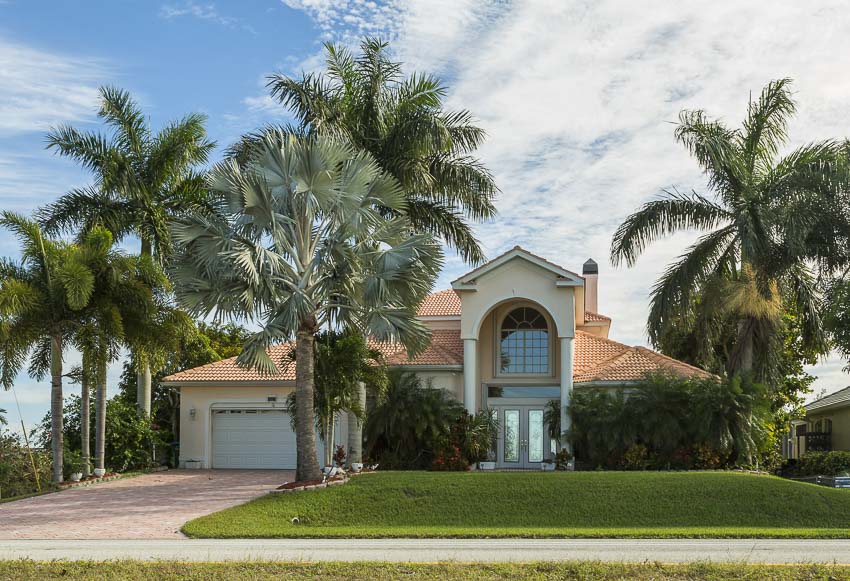Palm trees grow everywhere, from dry, sandy deserts to hot, steamy jungles, making them one of the most diverse trees in the world. Whether you plan on growing them indoors or outside in your yard, learn more about how to care for palm trees so you can enjoy their tropical vibes and stunning beauty.
Types of Palm Trees
There are over 2,600 species of palm trees, and they grow in a variety of habitats. In the United States, there are 14 native species of palm trees. While palm trees can tolerate different types of soil and climates, the one thing that all palm species have in common is their need for warmth.
In the US, most palm trees are native to the southeastern and southern states, like Florida, Georgia, Texas, Arkansas, Oklahoma, and California. No matter where you live, though, you can grow palm trees, whether it’s in your yard or in a container that you bring indoors during the winter.
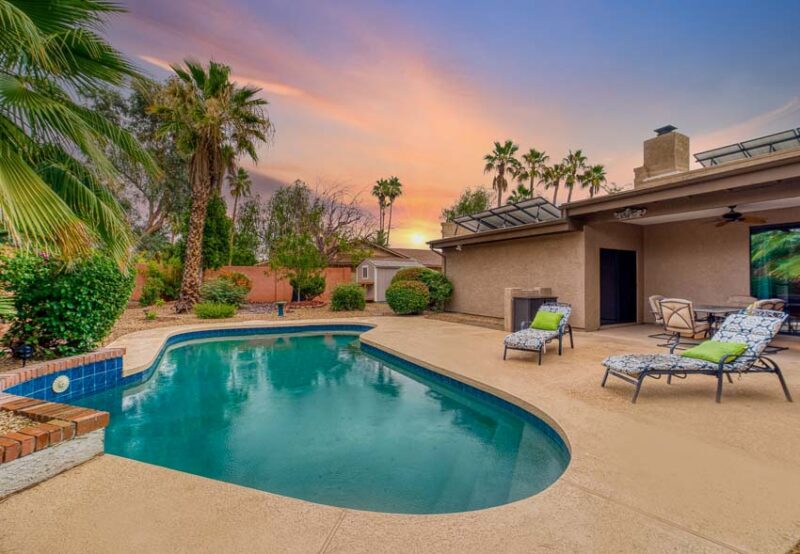
Selecting a species well-suited to your climate or indoor location will make your palm tree plant easier to care for and give it a better chance of thriving.
Palm trees come in many different sizes. The tallest palm tree ever recorded was about 190 feet tall. There are also dwarf palm trees that are more like shrubs than trees. When selecting a palm tree, choose from various types and sizes to find the best one for your climate and purpose.
Popular Indoor Palm Trees
Palm trees can make your indoor aesthetics feel tropical and exotic, so they are a popular choice for many types of decor. Many types of palm trees grow well indoors, and they thrive under the same light, temperature, and humidity conditions that people find comfortable.
Each type has unique care requirements since palm trees are a diverse species. In northern climates, they benefit from spending time outdoors during the frost-free parts of the year. Try one of these small palm tree species for indoor applications:
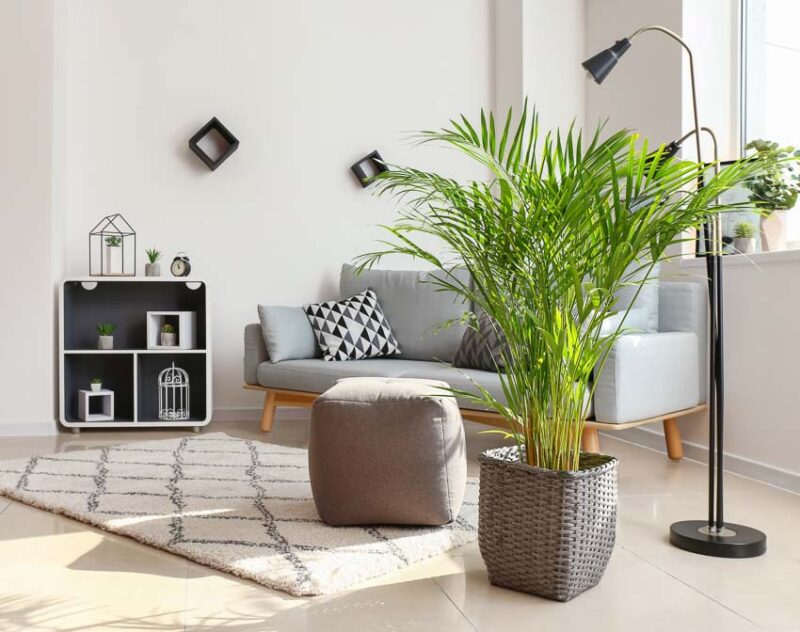
- Areca palm (Dypsis lutescens)–easy to grow indoors, has feathery green fronds
- Cascade palm (Chamaedorea cataractarum)–clumping growth, gets about 6 feet tall
- Chinese fan palm (Livistona chinensis)–slow growing, can get up to 15 feet tall, so the dwarf variety (subglobosa) is often selected for indoor plantings
- Majesty palm (Ravenea rivularis)–slow-growing, shade tolerant
- Parlor palm (Chamaedorea elegans)–will grow in artificial light, thrives in high humidity
Popular Outdoor Palm Trees
Growing palm trees outdoors is easier if you live in their native habitat. Many palm trees prefer a warm, tropical climate, but some like dry, desert climates. Since there are so many species, finding the right ones for your region is important.
Most palm species do better when grown in the ground, but you can also grow them outdoors in containers year-round. When growing palm trees in containers, choose slow-growing dwarf species and pay close attention to their water needs.
Palm trees can get quite tall, so ensure that they have plenty of room. If the space in your landscape is limited, select dwarf palm trees for the best results.
Tall Outdoor Palm Trees

Here are a few of the most popular palm trees for landscape plantings.
- California palm (Washingtonia filifera)–the only palm tree native to the Western United States, gets 40 to 60 feet tall, easy to grow
- Canary Island date palm (Phoenix canariensis)–grows 30 to 65 feet tall, slow growing, needs full sun, moderately salt-tolerant
- Caranday palm (Copernicia alba)–grows to 40 feet tall, cold hardy to zone 9a, an excellent choice for a wide range of soil types
- Mexican fan palm (Washingtonia robusta)–native to Baja California, can get up to 100 feet tall and live up to 500 years
Dwarf Outdoor Palm Trees
If you live in a warm climate, choose from any of the palm trees that are popular for growing indoors as landscape plants, as well as the following dwarf outdoor palm trees:
- European fan palm (Chamaerops humilis)–gets 6 to 10 feet tall, cold hardy to 10 degrees, perfect for containers or landscape plantings
- Dwarf palmetto (Sabal minor)–grows 2 to 10 feet tall with 3 to 5 feet spread, will tolerate partial shade, makes an excellent accent plant
- Pygmy date palm (Phoenix roebelenii)–gets up to 12 feet tall, one of the most popular choices for landscapes, grown in clumps of 2 to 4 plants with a spread of 6 to 8 feet
Hardiness Zones for Outdoor Palm Trees
It’s important to choose the correct species for your climate region. You can grow palm trees in several different hardiness zones. Some can even withstand a few weeks of snow and freezing temperatures.
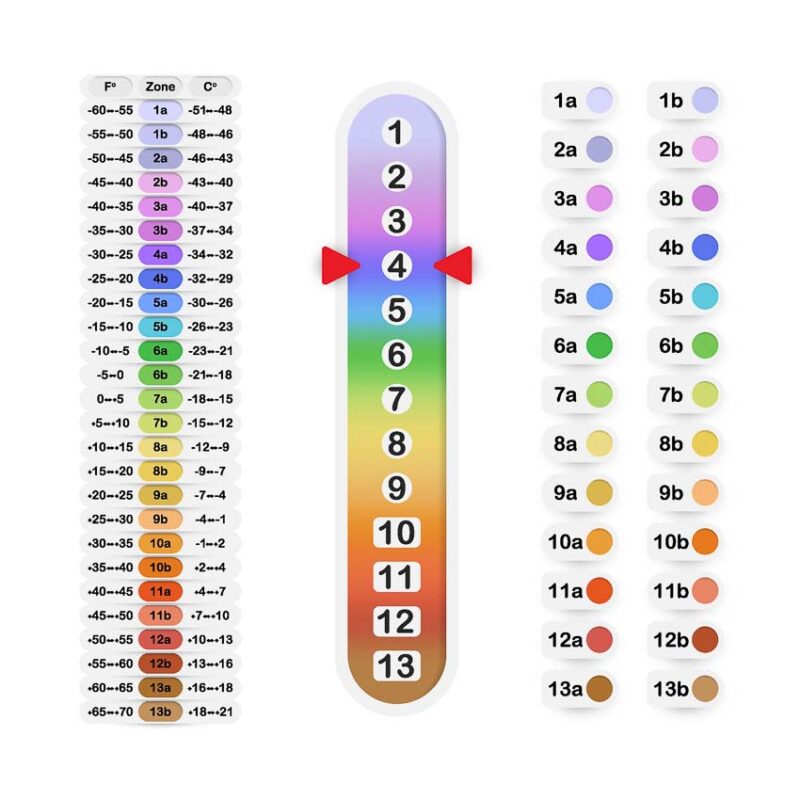
| Region | Hardiness zones | Suitable palm tree species |
| Cold | Zones 5 and 6 | Needle palm (Rhapidophyllum hystrix) |
| Mid | Zones 7 to 9 | Christmas Palm (Adonidia merrillii) and sugar palm (Arenga engleri) |
| Warm | Zones 10 to 13 | Florida thatch palm (Thrinax radiata) and zombie palm (Zombia antillarum) |
How to Care for Palm Trees: Essential Tips
Palm tree species have diverse native habitats, so it’s important to research them to ensure you provide them with what they need. Here are some general care tips for growing palm trees.
How to Care for Indoor Palm Trees
Growing palm trees indoors successfully starts with selecting the right type of palm tree. You also need to research soil, light, and moisture requirements for that species. Palm trees make wonderful indoor plants, and they are usually very easy to grow.
Palm trees can become quite large and tall when grown outdoors, but they are often stunted when you grow them in containers indoors. And they don’t usually flower or live as long as an outdoor palm tree. If your palm tree plant does reach the ceiling, don’t cut the growing tip because it will terminate all growth.
Ideal Indoor Conditions for Palm Trees
Depending on their native habitat, palm trees have different soil and moisture needs. Most palm trees prefer plenty of light and drier soil conditions. However, some types, like majesty palms, prefer moist soil, so it’s important to know what your species of palm tree needs.
In general, here are the ideal conditions for growing palm trees indoors:
- Soil–Palm trees prefer well-drained soil, so porous potting soil works fine. Make your own from peat moss, shredded bark, and leaf mold, or purchase a palm tree potting mixture.
- Fertilizer–Indoor palm trees need regular fertilizer to thrive, but some species only need to be fertilized once or twice a year.
- Light–Many species of palm trees grow in partial shade, and they easily adapt to low light conditions indoors.
- Water–Ensure that the soil remains consistently moist without getting waterlogged. Let the top inch of soil dry out between waterings. The watering frequency will depend on how humid your house is. In the winter, homes that are heated can become very dry.
- Humidity–Most palm trees prefer high humidity, so you may need to mist your palm tree or use a humidifier in the winter.
- Container–Palm trees don’t like to be disturbed and only need to be transplanted every few years. They have shallow root systems and like to be slightly pot-bound. When you purchase your palm tree, choose a slightly bigger pot than the one it came in and transplant it after you bring it home. Then, keep it well-watered during the first few weeks.
Common Indoor Palm Tree Problems and Solutions
Palm trees grown indoors can become stressed and develop diseases or nutrient deficiencies. The most common problems are overwatering, low light conditions, and lack of humidity, but improper fertilization is also an issue.
- Let the palm tree dry out between waterings, but make sure you are giving it enough.
- Fertilize up to three times per year, based on the trunk’s diameter, and use ½ to 1 pound of fertilizer per inch.
- Spray your palm tree with pesticides if you notice spider mites, mealybugs, thrips, and other insects.
- Most diseases result from improper care. Trim diseased parts of the plant and apply fungicides if necessary.
Outdoor Palm Trees
Knowing how to care for palm trees also requires knowledge about cultivating them in your landscape. It is actually easy, provided you have selected the right species for your region. Like all trees, palm trees need extra attention while they get established. The first 6 months to a year is the most critical time. You must pay close attention to the watering needs of your new palm tree.
Ideal Outdoor Conditions
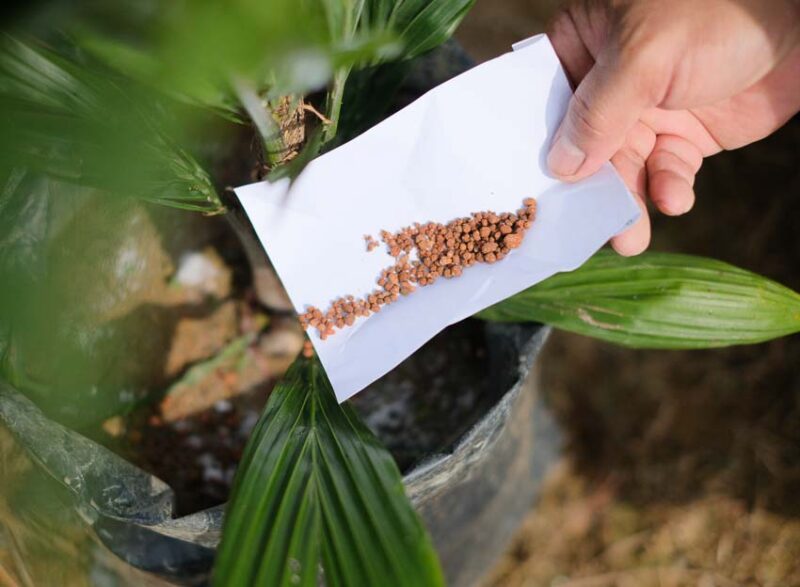
In general, here are the ideal conditions for growing palm trees outdoors:
- Soil–Sandy loam is the best type of soil for palm trees because they like well-drained soil. If you’re starting with heavy clay soils, mix in sand, peat moss, and pea gravel to ensure proper drainage. Don’t bury the trunk too deep when planting because it could cause the plant to rot.
- Fertilizer and other soil amendments–Use a slow-release fertilizer twice a year, in the spring and fall. Palm trees prefer a pH of 6.3 but tolerate pH levels of 5.5 to 7.5. Use pH test strips or get a soil test to determine what to add to your soil.
- Light–Plant palm trees in full sun to part shade. They need at least six hours of sunlight per day.
- Water–Once established, palm trees rarely need to be watered. During the first few months, water at least twice a week.
- Cold protection–Planting a palm tree in a protected area or microclimate will help make them more resistant to cold weather conditions. You can also wrap their trunk with burlap or freeze protection cloth. Water deeply before cold weather and use a thick layer of mulch to protect the shallow roots.
Common Outdoor Problems and Solutions
Most problems with palm trees result from growing them outside their native habitats. Here are some common problems with outdoor palm trees.
| Problem with outdoor palm trees | Symptoms | Solution |
| Fungal infections | Rotting trunk, wilting, slow growth | Prune infected areas and use a copper fungicide. Sterilize pruning tools to prevent reinfection. |
| Lethal yellowing | Yellowing and drooping fronds, wilting flowers, dropped fruits | Inject liquid terramycin in the trunk. Insects spread this disease, and severe infections may require complete removal of the infected tree. |
| Black fungus | Sooty black or gray mold on fronds | Insects cause this fungus. Treat the palm tree with horticultural oil. |
| Overwatering | Yellowing leaves, root rot, moldy soil, pests, brown leaf tips | Once established, outdoor palm trees rarely need to be watered. |
Proper pruning is important with outdoor palm trees. Since nutrients are stored in their fronds, don’t prune them unless they are dead. You can shock them by pruning more than 10 to 15% of their leaves.
How to Care for Palm Trees FAQs
How often should I water my palm tree?
Knowing how to care for palm trees also requires that you know how often to water them. You should water two to three times per week, but let the soil dry out between waterings. You rarely need to irrigate outdoor palm trees once established, but you should water them twice a week for the first 3 to 6 months.
What type of soil is best for palm trees?
Palm trees grow in well-drained soils, and they prefer sandy loam. If you have clay soil, add sand, peat moss, and pea gravel to ensure your palm tree doesn’t get waterlogged.
Do palm trees need a special fertilizer?
The best fertilizer for a palm tree has an 8-2-12 NPK ratio. They may also need extra manganese to prevent yellowing.
How do I protect my palm tree from pests and diseases?

When grown in the right climate and with plenty of light and space, palm trees are hardy plants that are easy to care for, and develop few diseases and problems. Avoid overwatering, and if your palm tree does develop a disease, remove the infected fronds and treat them according to the type of disease.
When is the best time to prune a palm tree?
Spring and early summer are the best times to prune a palm tree. Don’t over-prune, and only remove fronds that have turned completely brown.

